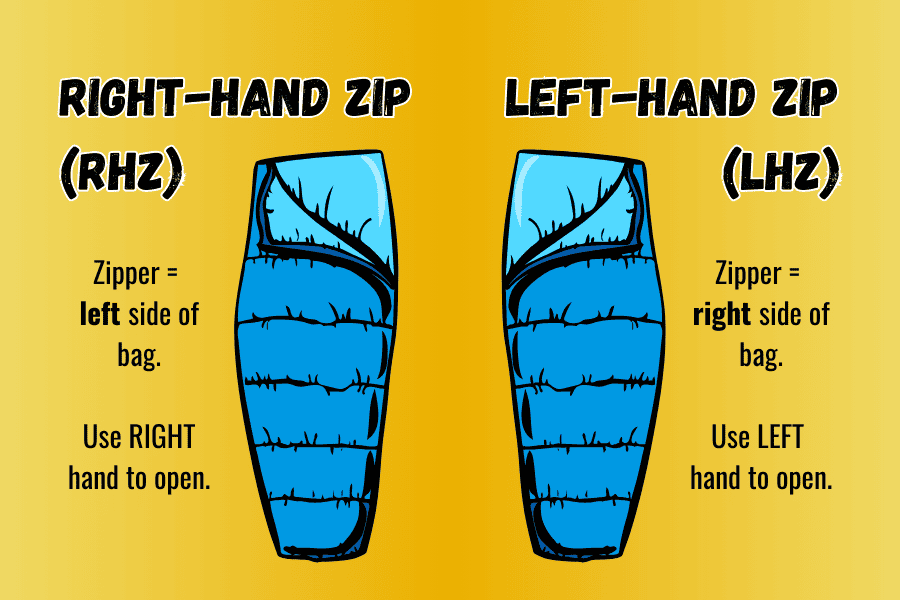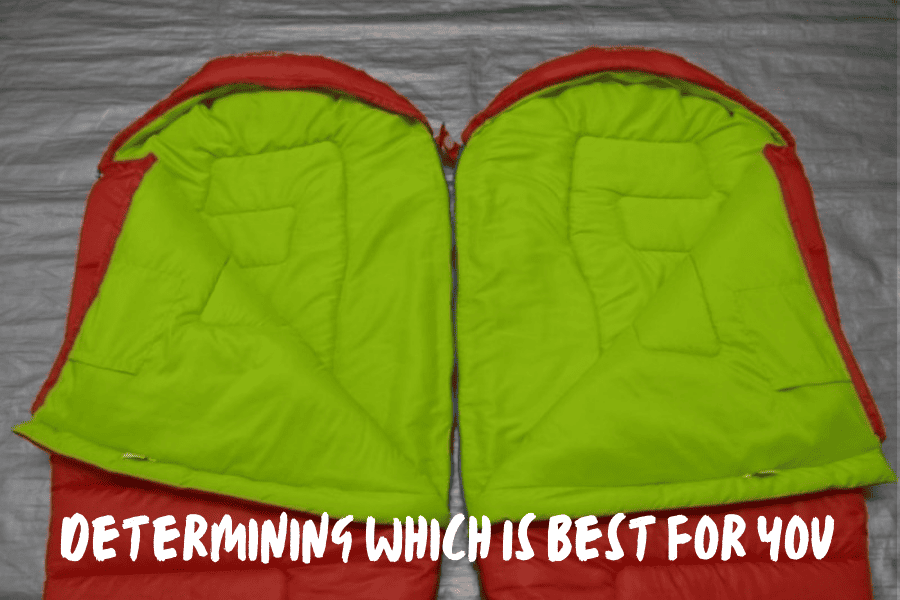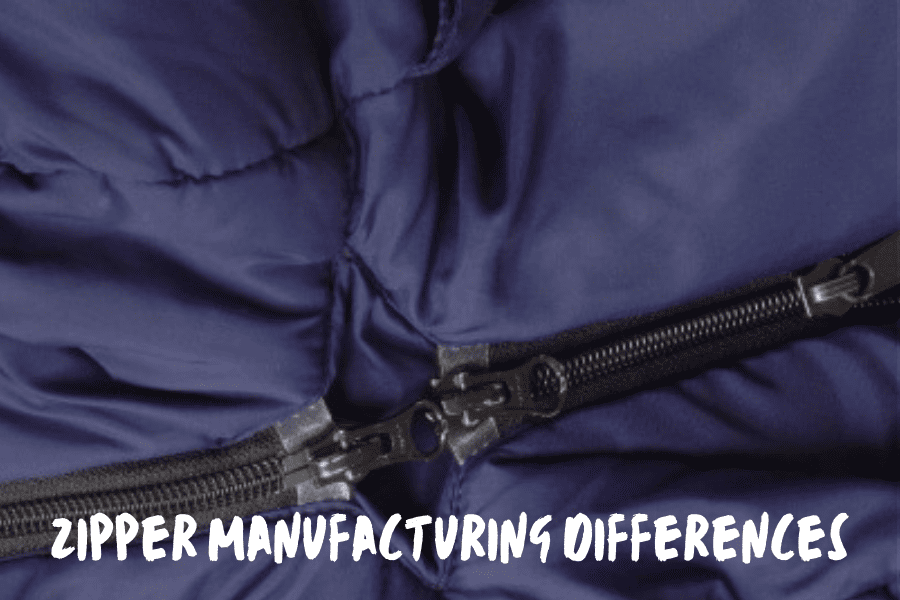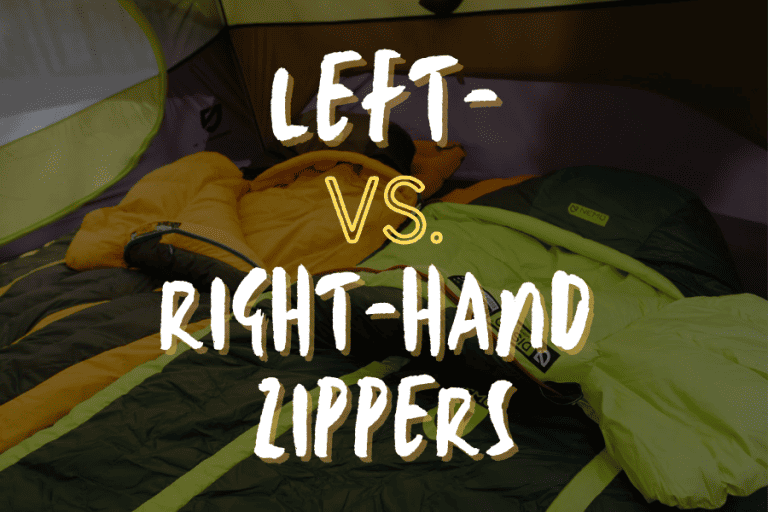Every sleeping bag has a zipper that runs down one of its sides to make it easier for you to get in and out of the bag. This is where the difference between left vs. right-hand zippers for sleeping bags is important.
Did you know that these zippers can be on either side of the sleeping bag – and that some manufacturers will let you choose which side to get yours on?
In this article, we’re going to dive into the ins and outs of zipper orientation, and what it can mean for your overall sleeping bag experience.
Table of Contents
ToggleBasics Of Sleeping Bag Zippers

Left-Hand Zip (LHZ)
Left hand zippers are going to be on the right side of your sleeping bag when you’re laying down. Confused yet? Don’t be!
Left hand zippers are designed to be used by the left hand when the camper is laying down in the sleeping bag.
This means that you will be able to reach your left hand across your body to unzip the bag with the most leverage.
Right-Hand Zip (RHZ)
Right hand zippers are the mirror to left-hand zip bags. With these, the zippers are on the left side of your sleeping bag when lying down.
With the same reasoning as the left hand zips, this allows right-handed campers to reach across their body to unzip the bag with ease.
It’s worth mentioning that because more individuals are right-handed, right-hand zips are far more frequent than left-hand zip bags.
Determining Which Is Best For You

For a lot of people, having the zipper on either side of your sleeping bag isn’t going to make a whole lot of difference in your camping experience.
That being said, there are certain circumstances having the zipper on one particular side of your bag might be more convenient.
Here are some things to consider when choosing a sleeping bag with a left or right hand zipper.
Righties Vs. Lefties
The most basic thing to consider is your dominant hand.
If you want to be able to use your dominant hand to zip and unzip your sleeping bag, just get a sleeping bag with the zipper on the opposite side.
So, if you’re right-handed – get a right-hand zip, and if you’re left-handed, get a left-hand zip.
Tent Entrance Orientation
If you have a tent with a side entrance, it’s better to have a sleeping bag with a zipper that’s facing that entrance.
That way, getting in and out of your tent is a lot quicker and easier, because you can just slide in and out, without having to shuffle around as much.
This is especially true if it’s a small 2- or 1-person tent.
Since you haven’t got a lot of space to move around inside these tents, having a zipper that’s facing the door makes things run a lot smoother.
Bivy Sack Alignment
This is the same deal as with tent doors. If you’re sleeping in a bivy sack, you want to make sure that your bivy and your sleeping bag have zippers on the same side.
Having the zippers aligned on the same side will make zipping and unzipping so much easier.
You’ll be able to do it all with one hand quickly and without any hassles.
Side Sleepers
Personally, I’m a tosser and turner. I flip back and forth between my right side, left side, and stomach all through the night.
However, some people always sleep on one particular side. If that’s you, you’ll want to get a sleeping bag with a zipper on that side.
It’ll make zipping and unzipping something you can do quickly, without having to flip around to find the zipper.
So, if you always sleep on your right side, get a sleeping bag with a left-hand zip (because that is what you will be facing) and vice versa.
Zipper Manufacturing Differences

Male Vs. Female Sleeping Bags
For the most part, the materials and zippers used in both men’s and women’s sleeping bags are going to be similar, if not identical.
However, the designs of men’s and women’s sleeping bags will vary to suit the general body composition of the genders.
In general, women’s bags will have more insulation and come in comparatively shorter sizes than men’s bags.
They will also have more curves to fit into the design of the sleeping bag, especially around the shoulders and hips.
These design changes are made to ensure that women, who usually lose heat throughout their core, will have extra insulation in those areas.
Women’s sleeping bag designs are also based around the average height of women, so you will notice they come in shorter size options.
In comparison, men’s bags have less insulation because men’s bodies, on average, retain more muscle – which in turn retains heat.
Additionally, men’s sleeping bags will come in longer sizes and won’t have quite as many curves incorporated into the design as women’s bags.
Brand Variations
While all sleeping bags will have side zippers, whether or not there are other zippers in other spots will depend on brand design.
For example, many manufacturers will add zippers throughout the body of the sleeping bag to add ventilation options.
These zippers can be placed on the top of the body, the sides, or near the foot box of the bag.
Having more zippers gives you more room to move, and it puts you in charge of the ventilation while you sleep.
pic
These designs can vary based on brand, so there’s plenty of options available for you to choose from.
Common Misconceptions
“One-Size-Fits-All”
Sleeping bags are designed to keep you warm based on a range of specifics, including your height, weight, and body composition.
This is why there are different sleeping bags designs based on gender and height.
One sleeping bag design will not work for everyone. A sleeping bag that works best for you is fit to your personal needs.
When you’re looking for a new sleeping bag, it’s always best to go to the store to check out a few models before purchasing one – or do plenty of online research.
The rule of thumb is to find a sleeping bag that caters to your height and gender (or body composition).
Gender Standards
Even though gender categories are a helpful tool to use when picking a sleeping bag, they are not set in stone!
The gender categories are based on the average “case” for each gender.
In general, women’s sleeping bags have more insulation because women are generally shorter and weigh less than men.
Comparatively, men’s sleeping bags have slightly less insulation and come in longer sizes.
That being said, go for it if you find that the other gender design works better for your body. You know what works best for you, so the call is yours at the end of the day.
Brand Product Compatibility
Never assume that two sleeping bags from the same brand will automatically be compatible if you wish to use them together.
Many brands use different models of zippers for different sleeping bag designs. And no matter how much you want it, two different zipper models will not work together.
Before you buy, make sure to read the product details and confirm the zippers are the same model and design.
Then, you’ll be able to make sure your bags will have compatible zippers – and that you can make a duo bag!
FAQs
Can Two Sleeping Bags With The Same Zipper Orientation Be Zipped Together?
No, two sleeping bags with the same zipper orientation cannot zip together because the zippers are not compatible.
If you want to zip two sleeping bags together, you’ll need two sleeping bags with opposite zipper orientations.
This way, the zipper “teeth” can alternate with one another to create a cohesive zipper.
How Can I Prevent My Zipper From Snagging?
The most common way to snag your zipper is on the fabric surrounding the zipper itself.
To avoid this, keep the surrounding fabric clear of the zipper teeth.
When I zip up my sleeping bag, I go slowly and use my hand to keep the fabric out of the way.
If my zipper does get caught, I carefully unzip it as much as possible until I reach the “snagged” portion of fabric.
Once you unzip from the caught portion, your zipper should run just as smoothly as it did before.
Why Do Sleeping Bags Have Two Zippers?
Some sleeping bags have two zippers to increase accessibility for both right- and left-handed campers.
Also, more zippers means more options for ventilation throughout the bag.
How Do You Zip A Sleeping Bag?
Starting at the bottom of the sleeping bag zipper, work the zipper up the length of the sleeping bag.
The “teeth” of the zipper will come together as the zipper rises up the length of the bag.
Make sure to go slowly to ensure that the fabric around the zipper doesn’t get caught in the zipper itself.
Wrapping Up
At the end of the day, whether your sleeping bag has a left vs. right-hand zipper is a minor point.
The only situation you can’t make do is if you want to mate two mummy-shaped sleeping bags into a double bag. In this situation, the zippers need to be on opposite sides.
In every other scenario, you can use a sleeping bag with the zipper on either side without any major issues.
If you have a tent with a side entrance, you’re better off with a zipper on the same side as the door.


